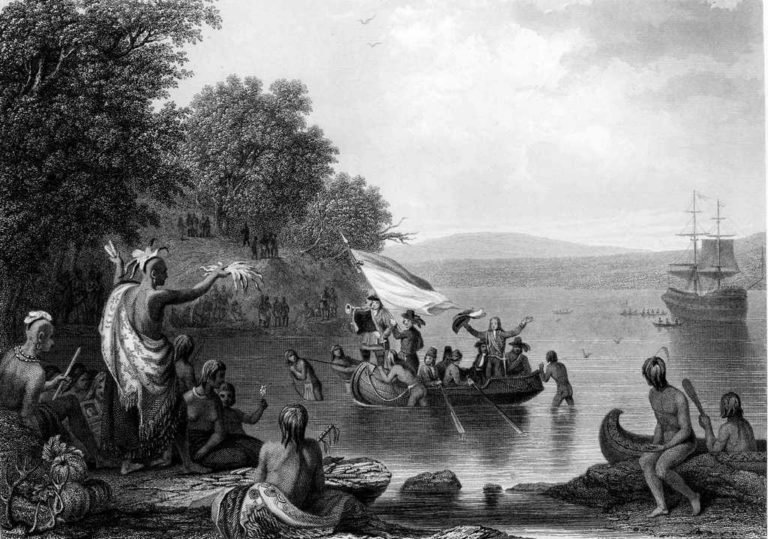The Four Voyages of Henry Hudson
by Joe Santacroce
It may be fair to say that Henry Hudson is one of the world’s most famous explorers. Yet there is much we do not know. Henry Hudson’s actual date of birth is not known. It is estimated around 1570 which would have made him around 37 years old when he made his first big voyage in 1607. He was married and had three children. He was English, not Dutch. By today’s standards, they might be considered middle class in that they could afford to live in a decent dwelling near the Tower of London and even afford a Maid Servant to help wife Katherine with the three boys, Oliver, John, and Richard.
We do know that his name was Henry and not Hendrick, as so often called and emblazoned on the newest and finest steamboat on the Hudson River at the time. Evidenced in his contract with the Amsterdam directors of the Dutch East India Company where he signed as Henry Hudson.
Nothing of certainty is known about his family or parents. There are family trees for Henry Hudson but many are filled with question marks. What is known is that he could read and write, understood mathematics, and knew how to navigate the stars.
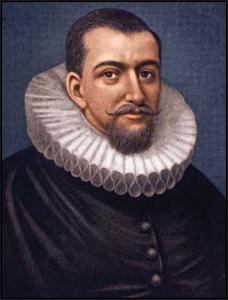
It is said that the portraits that commonly refer to him are certainly not him and that no authenticated portrait of him is known to exist. The pictures alleged to be likenesses of him were made after his death coming from the artists’ imaginations. All that is known about Henry Hudson covers his four voyages that occurred between 1607 to 1611.
Henry Hudson had one goal. That goal was to find a passage to the Orient and he wasn’t the first to try. Many had attempted before him. Europe’s population was growing, the economy was changing as well as strained. Food and clothing prices were at an all-time high and food was scarce. People were moving from the countryside to the city. Henry Hudson was on a mission and he had friends and influences in London to help him get started on his first voyage. It became his passion and that passion is what probably led to his death.
Henry Hudson – The First Voyage
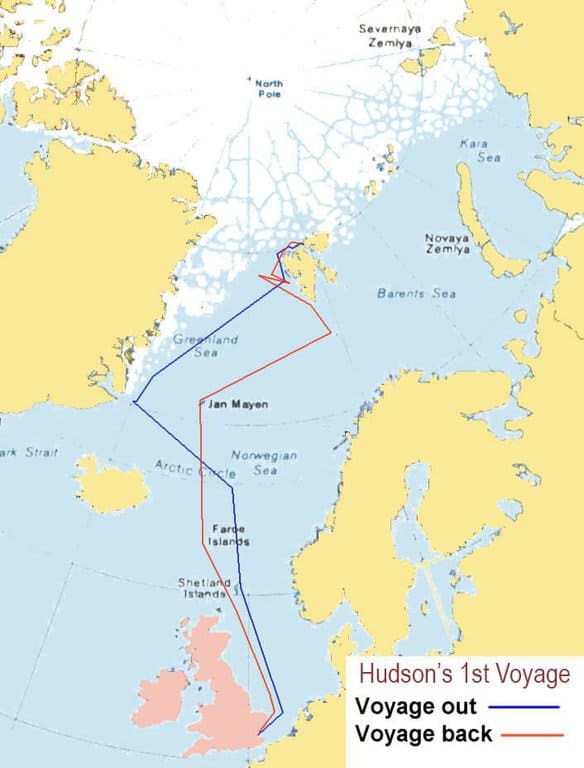
His first of four voyages began on May 1, 1607, as Captain of the ship Hopewell, sponsored by the English Muscovy Company for which it is believed his family had a history and\or stake in working for. He had a crew of 10 plus himself and his son John. The purpose of the trip was to discover a passage past the North Pole to Japan and China. Incredibly, Hudson, and others believed the waters would be warmer because the days were longer near the North Pole. At one point weather was so bad that he sailed blindly in snow along the coast of Greenland. Ice prevented him from reaching his goal. However, a great deal geographically was learned.
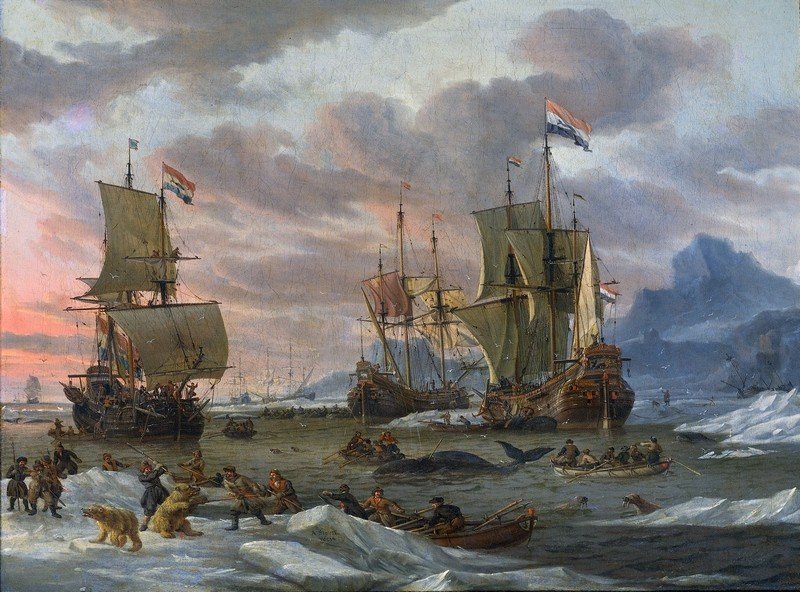
His report on the number of Whales led to others to begin Whaling in that area. Some writers and historians claim that the whaling boom that followed was a direct result of Henry Hudson’s sighting and that other nations sent expeditions as a result. Other accounts attribute this to explorer Jonas Poole in 1610 and others who followed.
From Henry Hudson’s Own Log
“July 14, 1607. At noon being a thick fog, we found ourselves near land . . . and running farther we found a bay open to the west. . . . The northern side of this bay’s mouth … is a small island which we called Collin’s Cape by the name of our boatswain who first saw it. In this bay we saw many whales, and one of our company having a hook and line overboard to try for fish, a whale came under the keel of our ship and made her held. Yet by God’s mercy we had no harm, but the loss of the hook and three parts of the line. In the bottom of this bay, John Colman, my mate, and William Collin, my boatswain, with two others of our company went on shore and there they found and brought aboard a pair of morse’s [Walrus] teeth in the jaw; they likewise found whale’s bones, and some dozen or more of deer’s horns, they saw the footings of beasts of other sorts, they also saw rote-geese, they saw much driftwood on the shore, and found a stream or two of fresh water. Here they found it hot on the shore, and drank water to cool their thirst. This night proved clear, and we had the sun on the Meridian, on the North and by East part of the compass, from the upper edge of the horizon with the cross-staff we found [its] height 10°40′ . . . from a north sun to an east sun, we sailed between north and north north east for eight leagues”.
Whether Henry Hudson or Jonas Poole can be credited with the find, within a decade the whale and walrus population was depleting. Sad commentary and footnote to the voyage but at the time this was seen as the highlight of the trip and if it was Hudson that got the credit it is what helped him to be able to make the second voyage after failing in the first. On September 15th after 3 ½ months away they pull back into port.
Henry Hudson – The Second Voyage
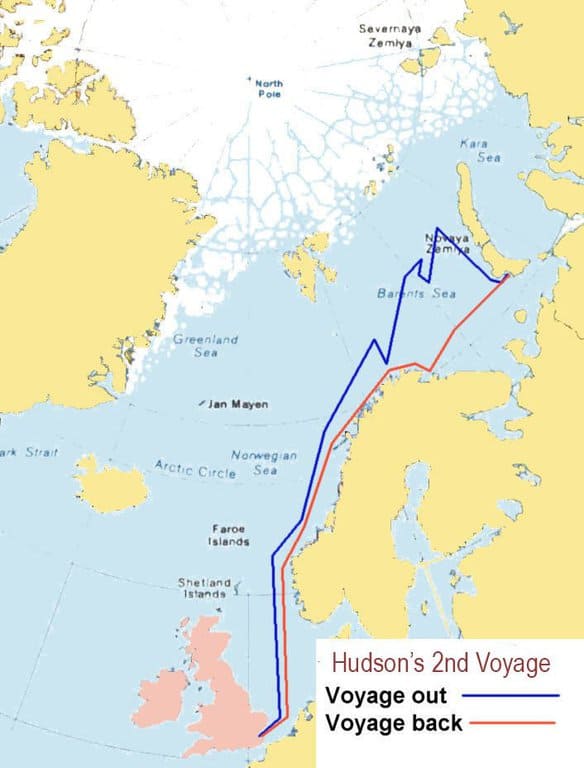
The second voyage begins eight months later on Friday, April 22, 1608, again sailing for the Muscovy Company on the Hopewell. This time Hudson is in search of a northeast passage going above Novaya Zemlya, an Island above Russia. His crew totals 13 including son John. Hudson demands additional men and that the ship is reinforced. Robert Juet joins the crew and is older than Hudson, literate, and an able seamen. But Juet also becomes part of the problem. Hudson himself describes Juet in his log as a man “filled with mean tempers”,
It is believed that Robert Juet also kept a log on the second voyage as he did on the third. But when pieces of Hudson’s journal were printed in 1625, Juet’s was not. The belief being in the interest of brevity. But if that was really the case we will never know as Juet’s log was never found. An investigation in 1841 by the New York State Legislature also turned up nothing more.
Near the end of June, they reach the island of Novaya Zemlya above Russia but ice prevented them from going further. They did some exploration and finding not only signs of many Walrus, Deer, Bear, and birds, they also find pieces of a broken Cross indicating they were not the first to pass this way.
Whether due to the cold, rough seas, or something else several of the men became ill on this voyage. At the end of May, beginning of June, the ship ran into snow and gales.
From Henry Hudson’s Own Log:
“June 9, 1608. In latitude 75°29′ we entered into ice, being the first we saw in this voyage; our hope was to go through it. We held our course between northeast and east northeast . . . until four in the afternoon at which time we were so far in and the ice so thick and firm ahead . . . that we had endangered us. We returned the way we had entered, with a few rubs of our ship against the ice.”
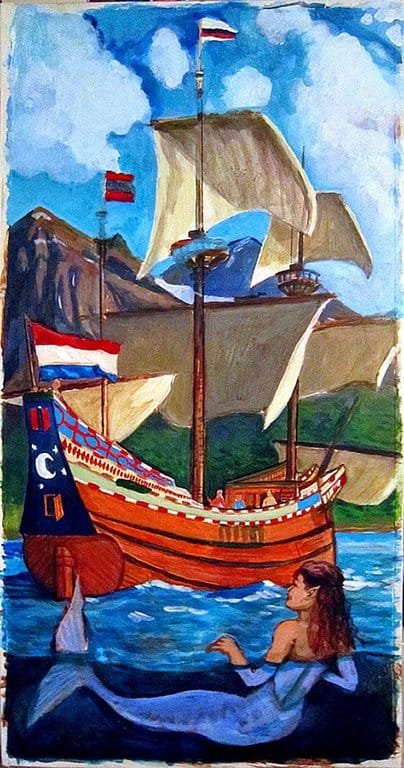
During the second voyage and documented in Hudson’s own hand was the Mermaid Incident. On June 15, 1608, as follows:
“This morning one of our companie looking over boord saw a mermaid, and calling up some of the companie to see her,one more came up and by that time shee was come close to the ships side, looking earnestly on the men. A little after a sea came and overturned her. From the navill upward her backe and breasts were like a womans, as they say that saw her, but her body as big as one of us. Her skin very white, and long haire hanging downe behinde of colour blacke. In her going downe they saw her tayle, which was like the tayle of a porposse, and speckled like a macrell. Their names that saw her were Thomas Hilles and Robert Rayner.”
It’s been suggested that this “Mermaid” was a seal, or perhaps just a faulty observation. But one has to wonder why did he give the names of witnesses?
Hudson decides to sail to North America. There were weeks of rain and the crew had enough. In his log, Hudson hints at a mutiny rising and decides it best not to waste time getting back to England and on August 26, 1608, he returns. The Muscovy Company Directors are none too pleased. Henry Hudson is now without a ship or employment.
Henry Hudson – The Third Voyage
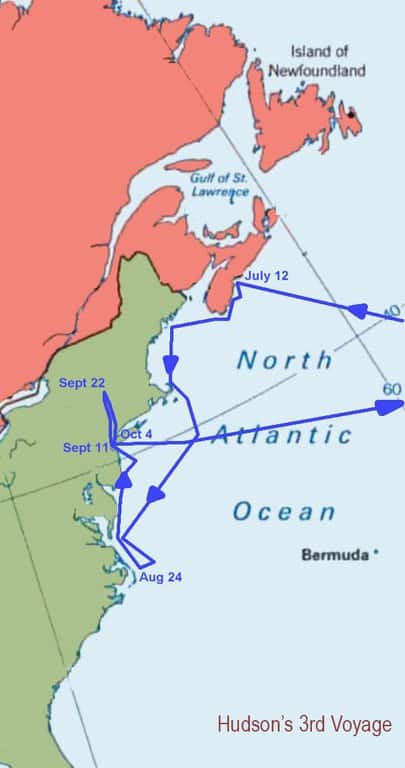
Hudson’s third voyage was for the Dutch East India Company on the Half Moon. He had fallen out of favor with the Muscovy Company after the last voyage. The French also wanted to hire Hudson but the Dutch, who were initially stalling, jumped at the chance when they heard the French wanted to employ his services.
While Hudson was negotiating a strict contract with the Dutch to sail back over Novaya Zemlya he received a package from his friend and famous Jamestown Settler, Captain John Smith, stating the belief that a passage to the West lay to the North through America. He sent Hudson some maps given to him by the Natives which later proved to include the Great Lakes.
As they head toward Novaya Zemlya it was frozen over and the men were freezing. Hudson propositioned the men to sail to America. Speculation that he used the information provided to him by Captain John Smith. The other option was to sail through Davis Straights which would provide no further comfort, or warmth. They headed for America.
Through the rest of May, June, July, and August the crew of the Half Moon sailed along charting the coastline and at different points stop and trade with the natives. They also had several altercations, particular on July 25th where Robert Juet writes in his log that:
From Robert Juet’s Log:
“In the morning we manned our scute with four muskets and six men, and took one of their shallops and brought it aboard. Then we manned our boat and scute with twelve men and muskets, and two stone pieces, or murderers, and drave the salvages from their houses, and took the spoil of them, as they would have done us.”
This seems to be his justification. What is troublesome is that it appears that Hudson does nothing about it or perhaps even condones it. What really happened, we will never know.
What we now know is that in September of 1609 Henry Hudson and his crew entered
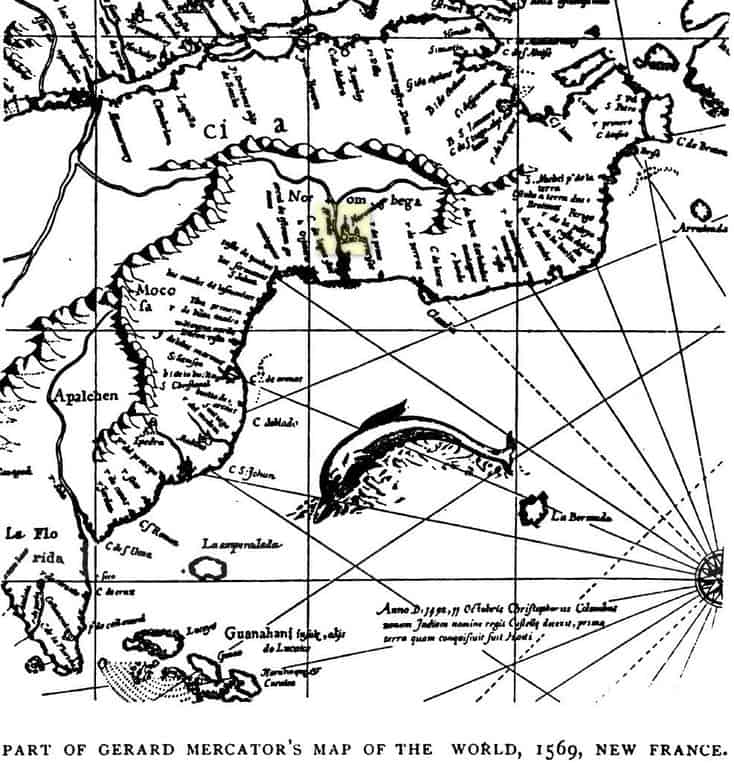
New York Bay and the now named Hudson River with the ultimate goal of finding a passage west. Although Hudson’s discovery can be disputed including Verrazzano’s log of 1524 describing entering the mouth of the bay, and earlier maps showing the Hudson River, including the 1569 New France Mercator Map showing a Fort near what is now Albany. What cannot be disputed is that to this point in time no one had clearly documented the river, it’s beauty, it’s natural resources, or the Native American life from where its mouth empties into the sea, to where their small ship could go no further. The trip up and down the river was full of excitement and surprises that reads like an adventure novel. It was not without misfortune and it was not without altercation and violence with the natives. Scholars to this day still debate the logs.
They anchored near what is now Albany on the 19th of September. They trade with the Natives. Then on the 20th, the small boat is sent out with several crew and they return at night with measurements for the river ahead which confirms they can go no further.
Hudson realizes at this point his quest is over. On the 23rd the ship is turned around and they start to head back down the river. While making their way down the river they have several more encounters with the natives both good and bad. What remains of Hudson’s log entries describe this new world as “pleasant a land as one can tread on”. He tells of visiting with the natives and of being treated well by them. Robert Juet’s log has a different perspective, stating more than once – “but we durst not trust them”.
On October 29th it is generally agreed that they anchored in Newburgh Bay. Robert Juet writes in his journal on the 29th:
From Robert Juet’s Log:
“The nine and twentieth was drie close weather ; the wind at south, and south and by west; we weighed early in the morning, and turned downe three leagues by a lowe water, and anchored at the lower end of the long reach ,- for it is sixe leagues long. Then there came certaine Indians in a canoe to us, but would not come aboord. After dinner there came the canoe with other men, whereoff three came aboord us. They brought Indian wheat, which we bought for trifles. At three of the cloeke in the after-noone wee weighed, as soone as the ebbe came, and turned downe to the edge of the mountaines, or the northermost of the moun- Moun- taines. taines, and anchored : because the high land hath many points, and a narrow channell, and hath manie eddie winds. So we rode quietly all night in seven fathoms water.”
They stop and trade with the natives along the way down and on the 30th the Half Moon anchors near Peekskill which although historians differ, many believe this is the location that refers to as “a very pleasant place to build a town on”. Some believe it was Newburgh. Others believe it was Cornwall.
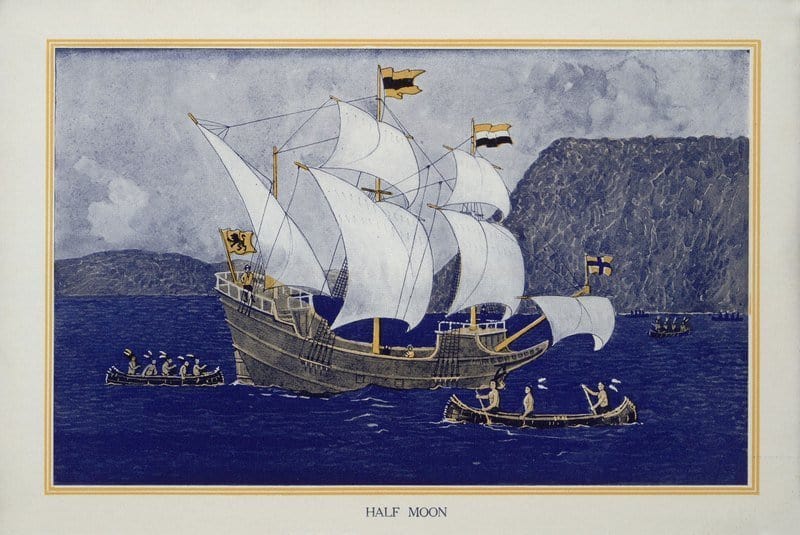
On the 2nd of October, they are ambushed by approximately 100 Natives including one of them that they held captive after an earlier altercation. Arrows are shot at the half moon and the Natives try to board but none of the crew are hit. Hudson orders the guns to be fired and several Natives are killed. The ship heads for the mouth of the river and then for Europe. The trip takes a month to return after being away for 7 1/2 months.
From Robert Juet’s Log:
“October 5, 1609- We continued our course toward England, without seeing any land by the way. All the rest of this month of October. And on the seventh day of November, being Saturday, by the grace of God we safely arrived in the range of Dartmouth, in Devonshire.”
What is interesting is they return to England, not Amsterdam. The ship is seized as are the logs and Henry Hudson is arrested for Treason and put under House Arrest for sailing for another country.
Henry Hudson did not find his passage. But the New World was about to change forever.
Henry Hudson – The Fourth Voyage
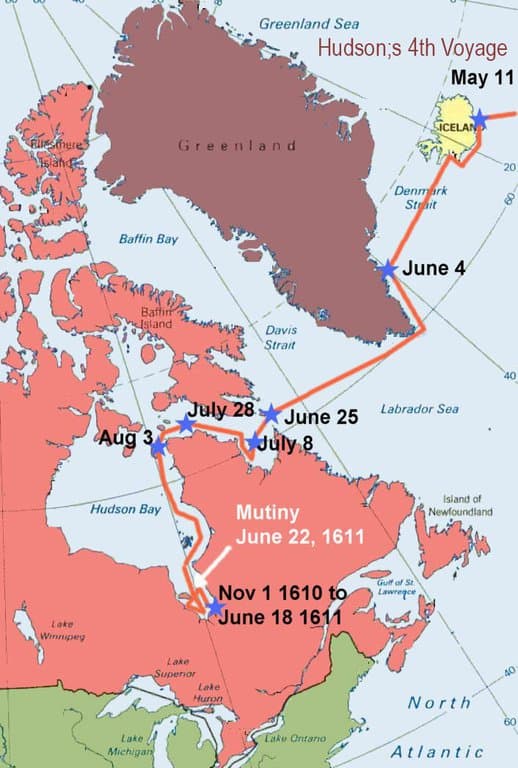
Henry Hudson’s fourth voyage began in April of 1610. Once again in search of a Northwest passage, and surprisingly sailing for England after his house arrest. He kept a journal but only pieces survive. The rest probably being destroyed by the mutinous crew.
After sailing towards Greenland and then across Davis Straight, he turns into the bay which now carries his name. In late June they ran into Ice. By November, and after a number of issues with the crew including jealousy, disobedience, scurvy, and freezing cold, a decision needed to be made whether to turn around and give up seeking a Northwest Passage or wait out the winter. They would need to build shelter, hunt, and fish, get firewood and hope that the Natives are not hostile. They would need to ground the ship to relieve the pressure on the hull so ice doesn’t crack it. One crew member had already died. Henry Hudson decides that they will stay and move on in the spring. A decision that will cost him his life.
On June 12, 1611, after a long and arduous winter, they were once again ready to set sail. Hudson had made some changes in the crew which did not go over well. They again get stuck in Ice and on June 20th Hudson turns the ship West but the crew wants to return. Provisions are running low and he orders a search of the ship and divides the remaining food including that which is spoiled, but some feel cheated.
On June 21st things go very bad.
The only account of the mutiny written by passenger Abacuck Prickett is disputed by all who have studied his account. But it is the only account we have. What is certain, is that Henry Hudson, his son John, and seven other men never returned.
Of the 12 remaining men, 4 died on the way home, including three responsible for the mutiny, including Robert Juet. Justice Served, – perhaps.
Although the remaining crew was questioned and recommended to hang. A trial did not officially take place until 1618 and several had already passed and some believe the sentence was never carried out. There are those that also believe that Hudson’s Voyage, and the reason he was allowed to sail for England again after his arrest upon his return from his third voyage and sailing for the Dutch, was a secret mission to search for Gold and Treasures for England.
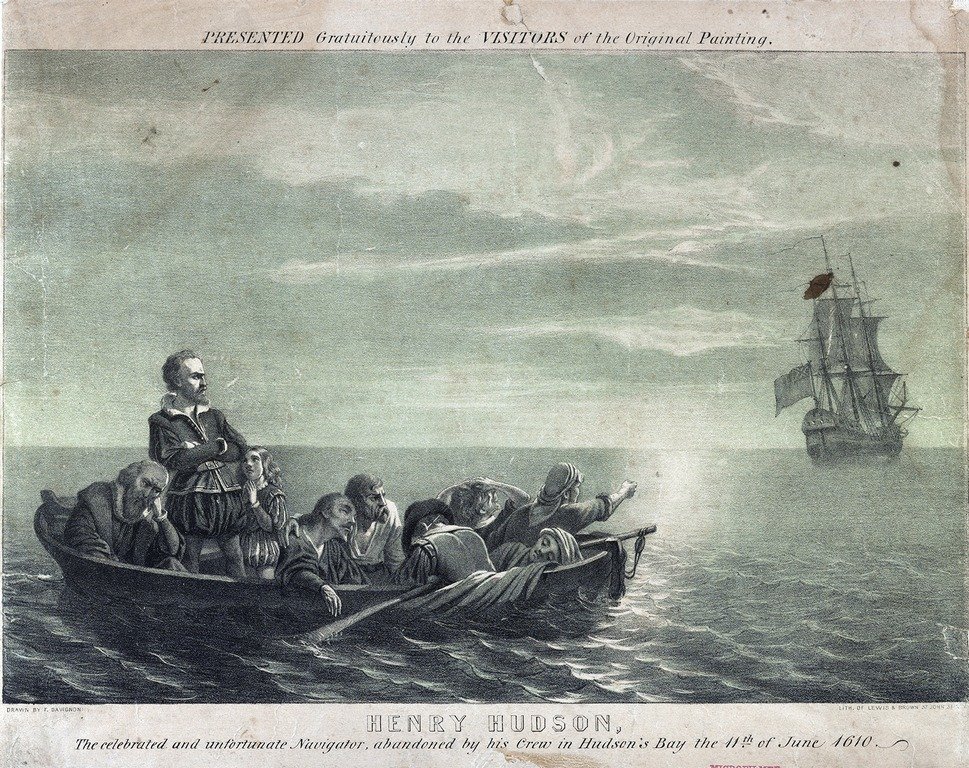
From 1607 to 1611 Henry Hudson made four attempts to find a passage to the far east. Each failed to meet their goal. Like other men and women, he was driven by a passion to succeed at no matter what the cost.
During his four voyages, there were at least three attempted mutinies, probably four. The last mutiny put him, his son, and seven others adrift in the icy waters of Hudson’s Bay. He sailed on three different ships during those four voyages, the Hopewell, Half Moon, and the Discovery. All three ships were subsequently sunk or captured after having gone on and sailed by other captains. There is little doubt that he was not the first to enter the river and bay at New York harbor. Yet Henry Hudson was a sought after captain, has more bodies of water named after him, and is carved in history, book, stone, and song.
The Video Version of this Article can be viewed at: “The Four Voyages of Henry Hudson”
References:
- Life and Voyages of Henry Hudson, by Ian Chadwick:
- Henry Hudson New World Voyager, by Edward Butts, 2009
- Henry Hudson – Dreams and Obsessions, by Corey Sandler, 2007
- Henry Hudson and the Dutch in New York. By Milton W. Hamilton, 1959.
- Hudson Tercentenary – An Historical Retrospective, by Frank Chamberlain, 1909
- A Brief Statement of his aims and Achievements, by Thomas Janvier, 1909
- Henry Hudson, Fatal Journey, The Final Expedition and of Henry Hudson, A Tale of Mutiny and Murder in the Artic, by Peter C. Mancall, 2009
- Henry Hudson and Robert Fulton, A Brief History of the Discovery of the Hudson River, by Edward Hagaman Hall, 1909
- Troys One Hundred Years 1789 1889, by Arthur James Weise, 1891
- Henry Hudson The Navigator, by George Michael Asher, 1860
- Adventures of Henry Hudson, by Alpheus Richards, 1842
